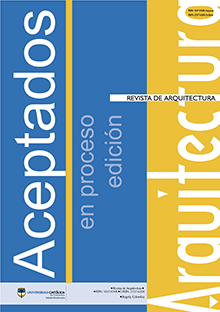
Este trabalho está licenciado sob uma licença Creative Commons Attribution-NonCommercial 4.0 International License.
A Revista de Arquitectura está catalogada como uma publicação de acesso aberto. Mais informações >>>
Os autores conservarão os direitos autorais e garantirão à Revista de Arquitectura o direito de primeira publicação da obra, o qual estará simultaneamente sujeito à licença Creative Commons (Atribuição-NãoComercial 4.0 Internacional CC BY-NC).
Os autores assinarão uma licença não exclusiva de distribuição da versão da obra publicada mediante a assinatura do documento RevArq FP03 Autorização para reprodução de artigo.
O autoarquivamento estará de acordo com os critérios expressos pelo SHERPA/RoMEO e pela classificação verde.
Para ver esses lineamentos, por favor, consultar >>>
Resumo
A Parede Trombe (PT) é uma estratégia arquitetônica passiva que utiliza a radiação solar para melhorar o desempenho térmico de edificações. Entretanto, a maioria dos estudos sobre essa solução têm se concentrado em climas temperados. Este trabalho visa analisar o impacto da presença e dimensões de respiradouros na camada interna de uma PT sobre o desempenho térmico de um ambiente, considerando períodos frios e quentes em duas zonas bioclimáticas brasileiras de clima ameno: Juiz de Fora (ZB3) e Brasília (ZB4). A metodologia baseou-se em simulações computacionais realizadas no software DesignBuilder, comparando diferentes configurações da PT com um modelo de referência sem a parede, nos períodos de inverno e verão. Os resultados indicaram que a PT sem respiradouros elevou a temperatura do ar interno em ambos os climas, com menor impacto no verão. Já a presença de aberturas intensificou o aquecimento, com variações de até 2,6 °C em Juiz de Fora e 2,9 °C em Brasília, devido à ação convectiva. No entanto, alterações nas dimensões dos respiradouros não apresentaram influência expressiva, indicando que a existência das aberturas é mais determinante que o seu tamanho.
Palavras-chave

Referências
Alharbi, K. A. M., Aldosari, O., Sina, N., Aybar, H. Ş., Fuxi, S., Alkhatib, S. E., & Mousa, A. A. A. (2022). Installation of rectangular enclosures filled with phase change nanomaterials on the thrombus walls of a residential building to manage solar radiation in different seasons of the year. Journal of Building Engineering, 57, 104732. https://doi.org/10.1016/j.jobe.2022.104732
Associação Brasileira de Normas Técnicas. (2005). Desempenho térmico de edificações – Parte 3: Zoneamento bioclimático brasileiro e diretrizes construtivas para habitações unifamiliares de interesse social (NBR 15220-3).
ASHRAE. (2017). Thermal environmental conditions for human occupancy (ASHRAE/ANSI Standard 55, Issue. ASHRAE. https://www.ashrae.org/technical-resources/bookstore/standard-55-thermal-environmental-conditions-for-human-occupancy
Bevilacqua, P., Benevento, F., Bruno, R., & Arcuri, N. (2019). Are Trombe walls suitable passive systems for the reduction of the yearly building energy requirements? Energy, 185, 554-566. https://doi.org/10.1016/j.energy.2019.07.003
Cavalcanti, F. S., & Caram, R. M. (2016). Avaliação do uso de fachada solar no litoral do nordeste brasileiro: o caso das paredes trombe. Revista Brasileira de Energia Solar, IV, 6. https://doi.org/10.59627/rbens.2013v4i1.93
Charqui, Z., El Moutaouakil, L., Boukendil, M., Hidki, R., Zrikem, Z., & Abdelbaki, A. (2023). Numerical simulation of turbulent coupled heat transfer in a Trombe wall subjected to periodic thermal excitations. Energy and Buildings, 278, 112631. https://doi.org/10.1016/j.enbuild.2022.112631
Chen, T., Liu, S., Wang, Y., Shen, Y., Ji, W., Xu, Z.,…Mazhar, A. R. (2025). An optimization method coupling the response surface methodology and multi-objective particle swarm to enhance the performance of a novel water Trombe wall. Applied Thermal Engineering, 267, 125785.https://doi.org/10.1016/j.applthermaleng.2025.125785
Facelli Sanchez, P., & Mercado Hancco, L. (2024). Trombe walls with porous medium insertion and their influence on thermal comfort in flats in Cusco, Peru. Energy and Built Environment, 5(2), 194-210.https://doi.org/10.1016/j.enbenv.2022.09.003
Fernandes, J. E. P., Mateus, R., & Bragança, L. (2012). Princípios de sustentabilidade na arquitectura vernacular em Portugal, Congresso Construção 2012, Coimbra, Portugal. https://repositorium.sdum.uminho.pt/bitstream/1822/22290/1/CC2012_Fernandes_Mateus_Braganca.pdf
Givoni, B. (1998). Climate considerations in building and urban design. John Wiley & Sons.
Guo, S. R., Jiang, X. C., Jia, Y. H., Xiang, M. L., Liao, Y. X., Zhang, W. T., ... & Long, E. S. (2023). Experimental and numerical study on indoor thermal environment of solar Trombe walls with different air-channel thicknesses in plateau. International Journal of Thermal Sciences, 193, 108469. https://doi.org/10.1016/j.ijthermalsci.2023.108469
Hami, K., Draoui, B., & Hami, O. (2012). The thermal performances of a solar wall. Energy, 39(1), 11-16. https://doi.org/10.1016/j.energy.2011.10.017
Hong, X., Leung, M. K. H., & He, W. (2019). Thermal behaviour of Trombe wall with venetian blind in summer and transition seasons. Energy Procedia, 158, 1059-1064. https://doi.org/10.1016/j.egypro.2019.01.257
Instituto Nacional de Meteorologia, I. (2016). Dados históricos. https://portal.inmet.gov.br/dadoshistoricos
Irshad, K., Algarni, S., Islam, N., Rehman, S., Zahir, M. H., Pasha, A. A., & Pillai, S. N. (2022). Parametric analysis and optimization of a novel photovoltaic trombe wall system with venetian blinds: Experimental and computational study. Case Studies in Thermal Engineering, 34, 101958. https://doi.org/10.1016/j.csite.2022.101958
Islam, N., Irshad, K., Zahir, M. H., & Islam, S. (2021). Numerical and experimental study on the performance of a Photovoltaic Trombe wall system with Venetian blinds. Energy, 218, 119542. https://doi.org/10.1016/j.energy.2020.119542
Jing, H., Chen, Z., & Li, A. (2015). Experimental study of the prediction of the ventilation flow rate through solar chimney with large gap-to-height ratios. Building and Environment, 89, 150-159. https://doi.org/10.1016/j.buildenv.2015.02.018
Krüger, E., Suzuki, E., & Matoski, A. (2013). Evaluation of a Trombe wall system in a subtropical location. Energy and Buildings, 66, 364-372. https://doi.org/10.1016/j.enbuild.2013.07.035
Lin, Y., Ji, J., Zhou, F., Ma, Y., Luo, K., & Lu, X. (2019). Experimental and numerical study on the performance of a built-middle PV Trombe wall system. Energy and Buildings, 200, 47-57. https://doi.org/10.1016/j.enbuild.2019.07.042
Luccas, A. V., & Matoski, A. (2023). Estudo da viabilidade da aplicação da parede “trombe” na região de Curitiba XVI Sicite, Ponta Grossa, Paraná.
Mabrouki, A., Bennani Karim, Y., Ouadghiri Hassani, H., Jamali, Y., & Khaldoun, A. (2023). A study of a passive heating design employing a Trombe wall with PCM: A numerical investigation of the semi-oceanic climate in Morocco. Materials Today: Proceedings, 72, 3626-3631. https://doi.org/10.1016/j.matpr.2022.08.410
Monghasemi, N., & Vadiee, A. (2018). A review of solar chimney integrated systems for space heating and cooling application. Renewable and Sustainable Energy Reviews, 81, 2714-2730. https://doi.org/10.1016/j.rser.2017.06.078
Monteiro, L. M. (2016). Parede Trombe: estudo experimental comparativo de desempenho térmico para aquecimento e arrefecimento na cidade de São Paulo Universidade de São Paulo. São Paulo.
Rabani, M., Kalantar, V., & Rabani, M. (2019). Passive cooling performance of a test room equipped with normal and new designed Trombe walls: A numerical approach. Sustainable Energy Technologies and Assessments, 33, 69-82. https://doi.org/10.1016/j.seta.2019.03.005
Saadatian, O., Sopian, K., Lim, C. H., Asim, N., & Sulaiman, M. Y. (2012). Trombe walls: A review of opportunities and challenges in research and development. Renewable and Sustainable Energy Reviews, 16(8), 6340-6351. https://doi.org/10.1016/j.rser.2012.06.032
Sergei, K., Shen, C., & Jiang, Y. (2020). A review of the current work potential of a trombe wall. Renewable and Sustainable Energy Reviews, 130, 109947. https://doi.org/10.1016/j.rser.2020.109947
Sheikholeslami, M., & Al-Hussein, H. R. A. (2023). Modification of heat storage system involving Trombe wall in existence of paraffin enhanced with nanoparticles. Journal of Energy Storage, 58, 106419. https://doi.org/10.1016/j.est.2022.106419
Simões, N., Manaia, M., & Simões, I. (2021). Energy performance of solar and Trombe walls in Mediterranean climates. Energy, 234, 121197. https://doi.org/10.1016/j.energy.2021.121197
Wang, D., Hu, L., Du, H., Liu, Y., Huang, J., Xu, Y., & Liu, J. (2020). Classification, experimental assessment, modeling methods and evaluation metrics of Trombe walls. Renewable and Sustainable Energy Reviews, 124, 109772 https://doi.org/10.1016/j.rser.2020.109772
Wu, S.-Y., Wu, L.-F., & Xiao, L. (2023). Effects of aspect ratio and inlet wind velocity on thermal characteristics of Trombe wall channel under different ventilation strategies: An indoor experiment. Experimental Thermal and Fluid Science, 141, 110800. https://doi.org/10.1016/j.expthermflusci.2022.110800
Zhou, S., & Razaqpur, A. G. (2024). CFD modeling and experimental validation of the thermal performance of a novel dynamic PCM Trombe wall: Comparison with the companion static wall with and without PCM. Applied Energy, 353, 121985. https://doi.org/10.1016/j.apenergy.2023.121985
Ziebell, C., & Aymone, J. L. (2020). Seleção de concepção de paredes PT. Design em pesquisa, 3, 546–563. https://lume.ufrgs.br/handle/10183/212664

































